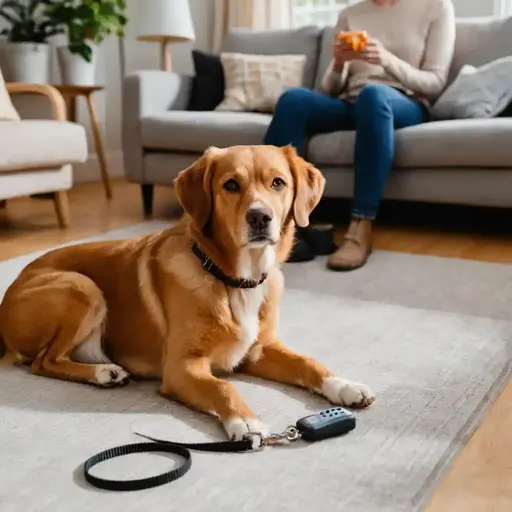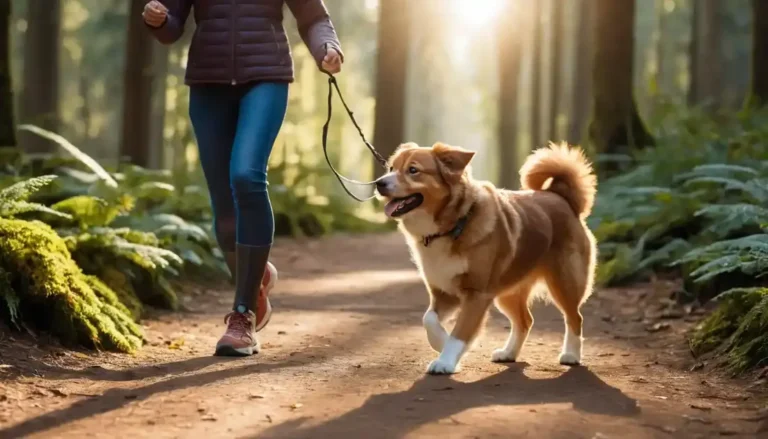You can teach your dog to heel without a leash by first mastering on‑leash heeling, then using high‑value rewards, gradually increasing distance, and adding distractions.
This step‑by‑step method builds a reliable “heel” cue that works even when the leash is off. The result? Confident walks, safer adventures, and a stronger bond with your canine companion.
In this guide, you’ll discover why off‑leash heeling matters, the essential prerequisites, two proven training methods, troubleshooting tips, advanced proofing, safety checks, and breed‑specific tweaks.
Why Off‑Leash Heeling Matters
Off‑leash heeling transforms a simple walk into a focused partnership. When your dog reliably stays at your side without a leash, you gain:
- Enhanced safety – you can navigate busy trails or parks knowing your dog won’t bolt.
- Greater freedom – your dog can sniff and explore while remaining under control.
- Sharper obedience – the focus required for heeling improves impulse control in other situations.
- Reduced anxiety – predictable cues calm dogs that are prone to stress in unpredictable environments.
- Stronger bond – consistent, positive communication deepens trust between you and your dog.
These benefits make learning how to Teach Your Dog to Heel Without a Leash a worthwhile investment for any dog owner.
Know more about Dog care from this free mini-course.

Prerequisites: Build a Strong Foundation
Before you attempt off‑leash heeling, your dog needs three core skills. Think of these as the foundation of a house; without them, any advanced training will wobble.
- Reliable basic commands – sit, stay, and especially come must be answered instantly.
- On‑leash heel proficiency – your dog should already walk by your left side on a leash without pulling.
- A trusting relationship – positive reinforcement, clear expectations, and calm leadership create the confidence needed for off‑leash work.
Checklist of Must‑Have Prerequisites
| Skill | How to Verify | Quick Test |
|---|---|---|
| Sit | The dog returns to you when called, even from 15 ft away. | Ask “Sit” in a low‑distraction area. |
| Stay | The dog holds the position for at least 5 seconds while you step away. | Practice “Stay” at the front door. |
| Come | The dog walks beside you, matching your pace, without pulling. | Call “Come” across the yard. |
| On‑leash heel | The dog shows excitement for training sessions and seeks your approval. | Walk a short distance in the house. |
| Trust | Offer a treat; the dog should approach calmly. | Walk a short distance to the house. |
If any of these items are shaky, spend a week reinforcing them before moving to the next stage of How to Teach Your Dog to Heel Without a Leash.
How to Teach Your Dog to Heel Without a Leash: Step‑by‑Step Training Plan
The core of this guide is a clear, repeatable plan that works for most dogs. You can follow Method 1 (Lure & Reward) or Method 2 (Shaping & Independence), or blend the two for a hybrid approach.
Tools You’ll Need
- High‑value treats – tiny pieces of cooked chicken, cheese, or freeze‑dried liver.
- Clicker or marker word – “Yes!” works as a reliable sound cue.
- Leash and harness – keep a leash handy for safety during early sessions.
- Quiet training area – start indoors or in a fenced yard to limit distractions.
Method 1 – Lure and Reward Technique
This classic method uses treats to guide the dog into the heel position, then gradually fades the lure.
- Create the cue
- Hold a treat in your left hand, let your dog sniff, then place the hand against your left thigh.
- Say “Heel” in a calm tone while tapping your left thigh.
- Take a few steps
- Walk 3‑5 steps forward. When the dog stays beside you, click or say “Yes!” and give the treat.
- Add turns and stops
- Practice left and right turns, sudden stops, and speed changes. Reward the moment the dog’s shoulders align with your leg.
- Fade the treat
- After the dog consistently follows the cue, reduce treat frequency: give treats every other successful heel, then every third, and eventually replace treats with verbal praise.
- Increase distance
- Move to a fenced yard. Start with 5‑ft intervals and gradually work up to 30 ft while maintaining the cue.
Method 2 – Directed Shaping Technique
Shaping encourages the dog to choose the correct position on its own, ideal for independent learners.
- Invite the position
- With a cheerful voice, say, “Fluffy, heel!” and point toward your left side.
- When the dog moves into place, click/mark and reward immediately.
- Gradual cue reduction
- Over several sessions, drop the verbal cue and let the hand gesture become the primary signal.
- Incorporate “Watch Me”
- Teach a “look” cue (“Watch me”) and use it before the heel cue to ensure eye contact.
- Proof with distractions
- Add low‑level distractions (a ball on the ground, a distant bark). Reward only when the dog stays in heel despite the stimulus.
Hybrid Approach – Combining Lure and Shaping
Many owners find success by starting with a lure for quick acquisition, then switching to shaping for long‑term independence. Use the lure for the first 5‑10 minutes of each session, then transition to shaping for the remainder.
Progression Timeline (Typical)
| Week | Focus | Goal |
|---|---|---|
| 1 | Cue creation & short indoor walks | The dog maintains heel through direction changes. |
| 2 | Turns, stops, and “watch me” | Dog maintains heel through direction changes. |
| 3 | Outdoor, low‑distraction yard | Heel for 15‑20 ft with occasional treats. |
| 4 | Moderate distractions (other pets, distant traffic) | Heel for 30 ft with 80% success. |
| 5+ | High‑distraction public spaces | Reliable off‑leash heel in parks & trails. |
Tip: Keep each training session to 5‑10 minutes. End on a positive note to cement learning.
Learn how to bond with your Dog with this free mini course.

Troubleshooting Common Issues
Even a well‑planned training schedule can hit snags. Below are the most frequent problems when learning how to Teach Your Dog to Heel Without a Leash, along with quick fixes.
Dog Pulls Ahead
- Why it happens: Excitement, lack of focus, or an over‑valued treat lure.
- Solution: Reduce the distance of each step, use a higher‑value treat, and reinforce the “heel” cue with an enthusiastic “Yes!”. Shorten sessions to 3‑5 minutes until the dog consistently checks in.
Dog Lags Behind
- Why it happens: Low motivation or confusion about the cue.
- Solution: Increase treat value (e.g., freeze‑dried liver), shorten the leash length temporarily for guidance, and add a quick “come” cue to draw the dog forward, rewarding the prompt response.
Distractions Overwhelm
- Why it happens: The Dog’s attention span is not yet proven.
- Solution: Return to a quieter environment, practice “watch me” for 5‑second eye contact, then gradually reintroduce the distraction. Use a “Let’s go!” cue to redirect focus.
Inconsistent Responses
- Why it happens: Infrequent practice or mixed signals.
- Solution: Schedule 2‑3 short sessions per day. Keep the cue word, hand signal, and reward timing identical each time. If the dog seems confused, revisit on‑leash heel for a refresher.
Regression After Success
- Why it happens: Fatigue, overuse of the skill, or an unbalanced reward schedule.
- Solution: Take a “training break” of a day or two, then restart at the last successful step. Re‑introduce a high‑value treat for the first few repetitions and taper off.
Pro tip: Always stay calm. Dogs pick up on our energy; a relaxed demeanor helps them stay focused.
Advanced Proofing & Maintenance
Once your dog can heel reliably in low‑distraction settings, it’s time to proof the behavior for real‑world reliability.
Heeling in Highly Distracting Environments
- Select a semi‑busy park – start near the perimeter where foot traffic is moderate.
- Use a “focus cue” – a distinct word like “Focus!” followed by a quick treat.
- Layer cues – combine a verbal “Heel” with a hand signal (palm facing your side).
- Reward distance – give a treat when the dog remains in heel for 10‑15 seconds after a loud bark or passing jogger.
Working With Other Dogs
- Controlled introductions – bring a calm, known dog on a leash. Practice heel while the companion dog walks parallel. Reward the dog for ignoring the other dog’s movements.
- Group classes – enroll in a “Heel on Cue” class where multiple dogs practice together. This normalizes social distractions.
Long‑Term Maintenance
| Frequency | Activity | Purpose |
|---|---|---|
| Daily (first 5 min) | Focused heel on the leash | Reinforce cue consistency. |
| 3×/week (10 min) | Off‑leash heel in a familiar yard | Keep skill fresh. |
| Monthly | Off‑leash heel in a new park | Test generalization. |
| As needed | “Emergency sit” or “stop” cue while heeling | Safety backup. |
Handling Setbacks
Off‑leash heeling is a privilege that comes with responsibility. Below is a concise safety checklist to keep you and your dog protected.
- Return to basics: If the dog struggles in a new environment, practice on‑leash heel there first.
- Refresh rewards: Occasionally reintroduce a novel treat to rekindle enthusiasm.
- Shorten duration: Focus on 5‑second successes before extending the time.
Pro tip: Keep a training journal (paper or app). Note the date, location, distractions, and success rate. Seeing progress on paper reinforces consistency.
Learn how to train your Dog better with this free mini course.
Safety & Legal Considerations
| Situation | Action |
|---|---|
| Unfamiliar public area | Carry a long leash for immediate recall. |
| Near wildlife | Stay alert; use “heel” to keep dog close. |
| Night walks | Use reflective gear and a light‑colored collar. |
| Extreme weather | Skip off‑leash sessions in heat or storms. |
| Legal restrictions | Check local leash laws before unsnapping. |

When to Keep the Leash On
- High‑traffic roads – even if the dog obeys heel, a sudden car can startle.
- Dog‑unfriendly zones – playgrounds, areas with aggressive dogs, or wildlife preserves.
- First‑time off‑leash – until both you and your dog feel confident.
Legal Responsibilities
- Know the rules – many municipalities require a visible leash in parks or require dogs to be under voice control.
- Respect signage – a “Leash Required” sign overrides your training.
- Cleanup – always carry waste bags; a responsible owner encourages community acceptance of off‑leash dogs.
Safety tip: Keep a backup leash in your pocket or attach a brief “emergency leash” to your belt. One quick snap can prevent a dangerous situation.
Tailoring Heeling to Breed, Size, and Personality
Every dog is unique. Adjust the training approach to match physical abilities and temperament.
Small Breeds (e.g., Chihuahuas, French Bulldogs)
- Step size: Use shorter steps; match their natural gait.
- Treat size: Tiny morsels prevent over‑feeding.
- Motivation: Many small dogs love praise and gentle petting more than food.
High‑Energy Working Breeds (e.g., Border Collies, Australian Shepherds)
- Add play: Incorporate a quick game of fetch after a successful heel.
- Increase variation: Use rapid direction changes and “sprints” to keep them engaged.
- Mental enrichment: End sessions with a puzzle toy to satisfy their problem‑solving drive.
Independent or Stubborn Dogs (e.g., Akitas, Shiba Inus)
- Use shaping: Let them choose the correct position, rewarding self‑initiated heel.
- Lower treat frequency: Too many treats may cause them to “work for food” rather than the cue.
- Stay consistent: A clear, unchanged cue is critical; avoid mixing verbal and hand signals.
Dogs with Anxiety or Fear
- Start with very low‑stimulus environments – a quiet room or fenced yard.
- Use a calm voice and slow movements to avoid triggering fear.
- Pair heel with soothing “relax” cue: After a heel, ask “Relax” and reward calm behavior.
General Tips for All Dogs
- Timing is everything – deliver the click/marker within 1 second of the correct behavior.
- Keep sessions positive – finish each session with a quick play or affection.
- Monitor health – ensure the dog isn’t over‑exerted; older dogs may need slower pacing.

FAQs
At what age can I start teaching heel without a leash?
Puppies as young as 8 weeks can learn basic eye contact and short heel steps, but reliable off‑leash heeling usually develops after the dog is 6 months old and has solid recall and on‑leash heel.
Is it safe to practice off‑leash heel in a public park?
Only if local regulations allow off‑leash dogs, your dog has a proven recall, and you start in a low‑traffic area. Gradually increase distractions while keeping a leash handy for emergencies.
My dog gets distracted by other dogs. How can I keep focus?
Begin training near a calm, well‑behaved dog on a leash. Use high‑value treats and the “watch me” cue to maintain eye contact. Reward the moment your dog stays in heel despite the other dog’s presence.
Can I use a clicker for off‑leash heel training?
Yes. A clicker provides a precise marker that tells your dog exactly which behavior earned the reward. Click the instant the dog’s shoulder aligns with your left thigh, then give the treat.
What if my dog refuses to heel without a leash?
Reassess the prerequisites: ensure basic commands are solid and on‑leash heel is reliable. Reduce distractions, shorten distance, and increase treat value. If problems persist, consult a certified trainer for a behavior assessment.
Conclusion
Teaching your dog to heel without a leash hinges on three pillars: a solid foundation, consistent, reward‑based practice, and gradual exposure to real‑world distractions.
Start with on‑leash heel, use lure or shaping methods, troubleshoot calmly, and proof the skill in varied environments. Remember to prioritize safety, respect local laws, and tailor the approach to your dog’s breed and personality.
Action step: Schedule three 5‑minute heel sessions this week—one indoor, one fenced‑yard, and one low‑distraction park—and track progress in a notebook. Within a month, you’ll enjoy confident, off‑leash walks that showcase the skill you’ve diligently taught your dog.






